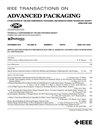Design and Fabrication of Large-Area, Redundant, Stretchable Interconnect Meshes Using Excimer Laser Photoablation and In Situ Masking
引用次数: 27
Abstract
Stretchable interconnects play an important role towards the realization of the realm of systems that include large-area sensor skins and wearable electronics. These interconnects must be reliable and robust for viability, and must be flexible, stretchable, and conformable to nonplanar surfaces for diverse applicability. This research describes the design, modeling, fabrication, and testing of stretchable interconnects on polymer substrates using metal patterns both as functional interconnect layers and as in situ masks for excimer laser photoablation. The fluences for photoablation of polymers are generally much lower than the threshold fluence for removal or damage of metals; thus, metal thin films that are designed as structural layers in the sensor skin can be used as in situ masks for polymers if the proper fluence is used. Self-aligned single-layer and multilayer interconnects of various designs (rectilinear and “meandering”) have been fabricated, and certain “meandering” interconnect designs can be stretched up to 50% uniaxially while maintaining good electrical conductivity and structural integrity. Furthermore, redundant interconnect meshes have been modeled and fabricated that increase the viability of the interconnect mesh while stretching up to 30% uniaxially and a prototype redundant interconnect mesh has been fabricated using seamless-scanning large-area fabrication techniques.利用准分子激光光烧蚀和原位掩模设计和制造大面积、冗余、可拉伸的互连网
可拉伸互连在实现包括大面积传感器皮肤和可穿戴电子设备在内的系统领域中发挥着重要作用。这些互连必须是可靠的和健壮的生存能力,必须是灵活的,可拉伸的,并符合不同的适用性的非平面表面。本研究描述了在聚合物基板上使用金属图案作为功能互连层和准分子激光光烧蚀的原位掩模的可拉伸互连的设计、建模、制造和测试。聚合物光烧蚀的影响通常远低于去除或破坏金属的阈值影响;因此,在传感器蒙皮中设计为结构层的金属薄膜,如果使用适当的通量,可以用作聚合物的原位掩模。已经制作了各种设计(直线型和“曲线形”)的自对准单层和多层互连,某些“曲线形”互连设计可以在保持良好导电性和结构完整性的同时单轴拉伸高达50%。此外,冗余互连网格已经建模和制造,增加了互连网格的可行性,同时单轴拉伸高达30%,并且使用无缝扫描大面积制造技术制造了原型冗余互连网格。
本文章由计算机程序翻译,如有差异,请以英文原文为准。
求助全文
约1分钟内获得全文
求助全文

 求助内容:
求助内容: 应助结果提醒方式:
应助结果提醒方式:


